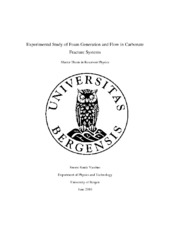| dc.description.abstract | This experimental thesis study foam generation during co-injection of gas and surfactant in three fracture systems with increasing size: 2- inch core, 4-inch core and a fractured block network. Important parameters established experimentally were 1) the gas fraction and injection rate that generated the strongest and most stable foams, 2) the injection strategy that produced the highest differential pressure, 3) the outlet conditions that reduced the gas compressibility effect, and 4) the effect of fracture system size to generate foam. The rock material used was an impermeable marble without porosity, and fluid flow and foam generation therefore only occurs within the fracture network itself. A total of 20 co-injections for in-situ foam generation were conducted to systematically evaluate the effects of differences in total injection rate, injection strategy (increasing/decreasing gas fraction flow) and backpressure conditions. The results show that the strongest foams were generated at high gas fraction (fg=0.8-0.9) for all three fracture systems, and corroborates with both theory and previous work. Foam stability was evaluated based on reduction in differential pressure from its peak (usually fg~0.8-0.9) to when only gas was injected (fg=1.0). Foam stability was influenced by the fraction of stationary/trapped gas, the injection rate and the effect of gas compressibility. Increased injection rate influenced foam stability negatively because of an increased viscous drag, and hence displacement of non-stationary foam bubbles, resulting in a decline in pressure. The highest relative increase (from start to peak) and the lowest reduction (from peak to end) in differential pressure was observed during co-injections with lowest (relative) total injection rate. In addition to consistent foam generation, hysteresis effects were observed when changing the injection strategy between subsequent co- injections for the 2-inch core and fractured block. Effects of hysteresis were especially apparent in the results from the 2-inch core, and displayed a substantial saturation of trapped gas, presumably due to considerable gas saturation prior to the co-injection with decreasing gas fraction. The significance of initial gas saturations on the effects of hysteresis was in accordance with the literature. A range of co-injections with variation in backpressure demonstrated that a sufficiently high backpressure reduced adverse gas compressibility effects and contributed positively on foam stability. Using an injection rate scaled for size, the larger 4-inch fracture system generated higher differential pressure compared with the 2-inch system. The 4-inch system demonstrated higher differential pressure for all gas fractions, with a more finely textured foam, which was observed in the transparent production tubing. Access to local changes in saturation was obtained through visual inspection for the block network, and using a positron emission tomography (PET) imaging approach for the two cores. PET visualization was performed at Haukeland University Hospital, applying the radioactive isotope 18F as a nuclear tracer in the liquid surfactant solution phase. The imaging displayed foam's ability to block and divert fluid flow as large variations in fluid distribution. | en_US |
